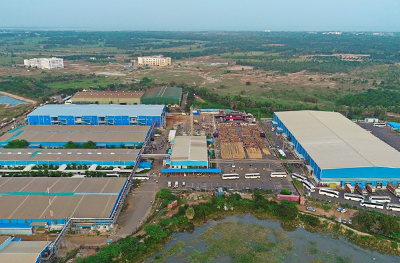A move by Foxconn Technology, the world’s largest contract assembler of consumer electronics, to increase Apple’s iPhone production in India will help both companies reach a large, crucial market as the Modi government dangles incentives.
Foxconn plans to expand a $1 billion electronics factory in the southeastern Indian town of Sriperumbudur over three years, Reuters and media outlets in Asia have reported since mid-July. The factory, which now assembles iPhone XRs will make other handsets for Apple after the expansion, the reports said.
Production in India opens the vendor and assembler to a market with 346 million smartphone users, and the Indian Cellular and Electronics Association expects that number to more than double – to reach 820 million – by 2022.
More production in India will let Foxconn diversify away from China, where costs are rising, on a journey that has already taken the assembler to Vietnam and the United States.
“For Foxconn, the advantage is to diversify its supply chain and reduce its dependence on China, which has been done in sync with Apple,” said Koushan Das, assistant manager for business intelligence with the consultancy Dezan Shira and Associates in New Delhi.
Benefits for Apple
Local production gets Apple past a 20% tax on phone imports into India and cuts overall costs, making the goods cheaper for consumers.
“For Apple, the Indian market has been very competitive, mostly due to the high prices of the product, which increases further due to the import tax on phones,” Das said.
Production in India will help Apple follow government rules that at least 30% of iPhone content be sourced locally, said Eddie Han, senior analyst with the Market Intelligence and Consulting Institute in Taipei.
Apple “has no choice” but to outsource those orders to Foxconn for assembly in India while promising to continue relocating “related supply chains” to the country, he said.
“On top of that, Apple has seen India as a sizeable market with high potential,” Han said.
Despite the restrictions, India raised its appeal among foreign investors by waiving tariffs on foreign imports to boost mobile manufacturing by groups such as Foxconn and Samsung, analysts believe.
“India has recognised that handset manufacturing in India has a disability for not possessing the capability of high-end handsets like other competing economies,” said George Paul, CEO of the Manufacturers’ Association for Information Technology (MAIT).
“This is translating to incentives like the production-linked incentive scheme for handset manufacturing, with provisions that can attract global majors because they have much higher ability with high-value handsets in India.”
Tax Breaks
Government incentives also include a cut in corporate income tax from 30 to 22% in September and it has waived tariffs plus income tax for companies in special economic zones.
“With the government offering significant benefits in the form of tax breaks for production companies, locally manufactured phones will allow the company to be more competitive with other brands such as Samsung,” Das said.
Labour costs 15% less in India than in China, estimates Vinkat Pasupuleti, manager of a $130-million India fund under Dalton Investments in the United States.
That apart, one of the challenges faced by ASEAN countries, which account for a significant share in global handset manufacturing space, is that their labour markets are smaller and tighter, Paul said.
“Whereas the labour pool in India is still so large, and much cheaper, that the industry is unlikely to reach saturation point anywhere in future,” he said.
MAIT claims to represent 70% of mobile handsets makers in India, including Samsung, Apple, Xiaomi, and Wistron.
Foxconn now operates 12 factories in nine Chinese cities, more than in any other single country. The plants in China are known for making iPhones and iPads.
But Foxconn, like other foreign investors in China, faces rising costs and higher tariffs on shipments to the United States that have been netted in the two-year-old Sino-US trade dispute.
Sales income for the company also known as Hon Hai Precision declined 7.16% year-on-year to NT$2 trillion ($68 billion) in the first half of 2020.
Foxconn declined to comment, citing “company policy and commercial sensitivity.” The company cannot discuss specific operations of its work for any customer, a publicist said. Apple did not reply to e-mailed requests for comment.
Pegatron, Wistron Also Coming
But there will be competition too. Two of Foxconn’s Taiwan-based peers, Pegatron Corp and Wistron, are eyeing growth in India. Both take orders from Apple.
Pegatron was applying for permits in July as the first stage in doing business in India, a company spokeswoman said. She noted India’s labour force and consumer market size but suggested they weren’t the only reasons.
Wistron plans to invest $165 million in a plant near Bengaluru, India-based news website The Economic Times reported in May. Wistron in 2016 became the first company to produce iPhones in India and has exported some to Europe.
Non-Apple smartphone makers such as LG and Oppo already produce handsets in India and Taiwanese assemblers “have followed suit”, Han said.
Foxconn could qualify for Indian government help under its Production-Linked Incentive Scheme – PLI for short, said Prachir Singh, a senior research analyst with tech market analysis firm Counterpoint.
“Foxconn is a relatively early entrant to the Indian smartphone manufacturing ecosystem and has scaled up its manufacturing operations to a massive scale,” Singh said. “It is leveraging its current infrastructure (and) good relationships with the local government as well as local talent. The current PLI scheme has been a key motivator for the additional investment in India.
“Given the population size and domestic market consumption in India, in the long run, the manufacturing industry will have the potential to emerge and grow into as strong as today’s China,” Singh said.
• By Ralph Jennings and Indrajit Basu.
This report was updated on Dec 27, 2021 for style purposes.
Read More:
Apple Pursues China+1 Strategy To Minimise China Risk
Apple Vendors Pledge $900m in India To Pursue China +1 Strategy
Apple Plan to Ramp Up Production in India ‘Will Spur Sales Surge’






















